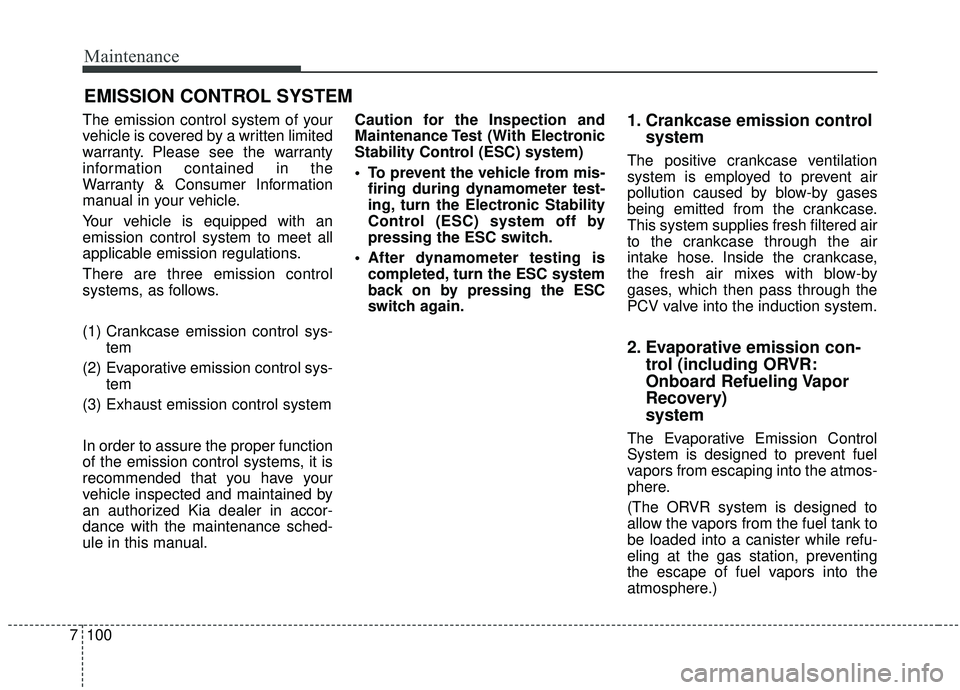Page 531 of 555

Maintenance
100
7
EMISSION CONTROL SYSTEM
The emission control system of your
vehicle is covered by a written limited
warranty. Please see the warranty
information contained in the
Warranty & Consumer Information
manual in your vehicle.
Your vehicle is equipped with an
emission control system to meet all
applicable emission regulations.
There are three emission control
systems, as follows.
(1) Crankcase emission control sys-
tem
(2) Evaporative emission control sys- tem
(3) Exhaust emission control system
In order to assure the proper function
of the emission control systems, it is
recommended that you have your
vehicle inspected and maintained by
an authorized Kia dealer in accor-
dance with the maintenance sched-
ule in this manual. Caution for the Inspection and
Maintenance Test (With Electronic
Stability Control (ESC) system)
To prevent the vehicle from mis-
firing during dynamometer test-
ing, turn the Electronic Stability
Control (ESC) system off by
pressing the ESC switch.
After dynamometer testing is completed, turn the ESC system
back on by pressing the ESC
switch again.1. Crankcase emission control system
The positive crankcase ventilation
system is employed to prevent air
pollution caused by blow-by gases
being emitted from the crankcase.
This system supplies fresh filtered air
to the crankcase through the air
intake hose. Inside the crankcase,
the fresh air mixes with blow-by
gases, which then pass through the
PCV valve into the induction system.
2. Evaporative emission con-trol (including ORVR:
Onboard Refueling Vapor
Recovery)
system
The Evaporative Emission Control
System is designed to prevent fuel
vapors from escaping into the atmos-
phere.
(The ORVR system is designed to
allow the vapors from the fuel tank to
be loaded into a canister while refu-
eling at the gas station, preventing
the escape of fuel vapors into the
atmosphere.)
Page 541 of 555
87
Specifications & Consumer information
RECOMMENDED LUBRICANTS AND CAPACITIES
To help achieve proper engine and powertrain performance and durability, use only lubricants of the proper quality.
The correct lubricants also help promote engine efficiency that results in improved fuel economy.
These lubricants and fluids are recommended for use in your vehicle.
Lubricant VolumeClassification
Engine oil *1*2
(drain and refill)
Recommends
Gasoline Engine
Lambda II PE 3.3L T-GDI6.9 l (7.29 US qt.)API SM/ILSAC GF-4 or above
Theta II 2.0L T-GDI5.7 l (6.02 US qt.)API SN
Automatic transaxle
fluidGasoline
Engine Theta II 2.0L T-GDI
9.2 l (9.71 US qt.)GS ATF SP-IV-RR
KIA genuine ATF SP-IV-RR
Lambda II PE 3.3L T-GDI
CoolantGasoline EngineTheta II 2.0L T-GDI8.8 l (9.29 US qt.)Mixture of antifreeze and distilled
water
(Ethylene glycol base coolant for aluminum radiator)
Lambda II PE 3.3L T-GDI11.6 l (12.25 US qt.)
Brake fluid0.395 l (0.42 US qt.)FMVSS116 DOT 3 or DOT 4
Page 542 of 555

88
Specifications & Consumer information
Lubricant VolumeClassification
Rear differential oil (without LSD)
(Theta II 2.0L T-GDI) *31.2 l (1.27 US qt.)HYPOID GEAR OIL API GL-5 SAE 75W/85
(SK HK SYN GEAR OIL 75W85)
Rear differential oil (without LSD)
(Lambda II PE 3.3L T-GDI) *31.3 l (1.37 US qt.)
Rear differential oil (with LSD)
(Theta II 2.0L T-GDI) *3*41.3 l (1.37 US qt.)HYPOID GEAR OIL API GL-5 SAE 75W/85
(SK HK JL SYN LSD GEAR OIL 75W85 PLUS)
Rear differential oil (with LSD)
(Lambda II PE 3.3L T-GDI) *3*41.4 l (1.48 US qt.)
Front differential oil *3
(AWD)0.7 l (0.74 US qt.)HYPOID GEAR OIL API GL-5 SAE 75W/85
(SK HK SYN GEAR OIL 75W85)
Transfer oil
(AWD)Gear/ Clutch0.57 l (0.60 US qt.)
SHELL TF 0870B
Actuator0.25 l (0.26 US qt.)
FuelGasoline Engine60 l (63.36 US qt.)Refer to Fuel requirements in chapter 1
*1: Refer to the recommended SAE viscosity numbers on the next page.
*2: Engine oils labeled Energy Conserving Oil are now available. Along with other additional benefits, they contribute to fuel economy by reducing the amount of fuel necessary to overcome engine friction. Often, these improvements are difficult to measure in everyday driving, but in a year’s
time, they can offer significant cost and energy savings.
*
3: Regardless of oil change intervals, replace oil immediately if Rear-Differential or Front-Differential is submerged.
*4: Be sure to inject oil for exclusive use of LSD when replacing Rear Differential (for LSD) Oil.
Page 543 of 555

89
Specifications & Consumer information
Recommended SAE viscosity
number
Engine oil viscosity (thickness) has an
effect on fuel economy and cold
weather operating (engine start and
engine oil flowability). Lower viscosity
engine oils can provide better fuel
economy and cold weather perform-
ance; however, higher viscosity
engine oils are required for satisfacto-
ry lubrication in hot weather. Using
oils of any viscosity other than those
recommended could result in engine
damage. When choosing an oil, con-
sider the range of temperature your
vehicle will be operated in before the
next oil change. Proceed to select the
recommended oil viscosity from the
chart.
An engine oil displaying this API Certification Mark con-
forms to the international Lubricant Specification
Advisory Committee (ILSAC). It is recommended to only
use engine oils that uphold this API Certification Mark.
Temperature Range for SAE Viscosity Numbers
Temperature°C
(°F)-30 -20 -10 0 10 20 30 40 50 -10 0 20 40 60 80 100 120
Gasoline
Engine Oil
Lambda II PE 3.3L T-GDI *
1
Theta II 2.0L
T-GDI *
2
20W-50
10W-30
15W-40
0/5W-30, 5W-40
*1: For better fuel economy, it is recommended to use the engine oil of a viscosity grade SAE 5W 30 (API SM/ILSAC GF-4 or above). However, if the engine oil is not available in your country,
select the proper engine oil using the engine oil viscosity chart.
*
2 : For better fuel economy, it is recommended to use the engine oil of a viscosity grade SAE 0W 30 (API SN or above). However, if the engine oil is not available in your country, select the prop-
er engine oil using the engine oil viscosity chart.
10W-30
5W-30